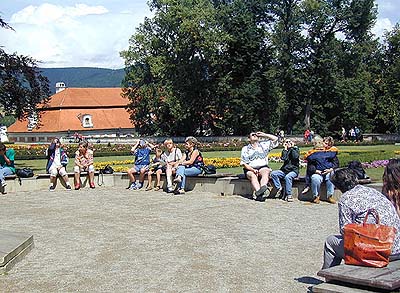Castle garden in the 20th century
From the beginning of our century come the first preserved photographs of the castle garden. They document the then fashionable ornamental festival summer plantings, bordering along both sides of the main path in the garden. The most demanding flower adaptation was traditionally planted on the parterre in front of the summerhouse Bellarie. The regular and intensive maintenance of the castle garden lasted until the end of the Schwarzenbergs\' administration of the Český Krumlov castle in 1940.
After the second world war the state of the garden progressively worsened, mostly due to a lack of labor force.
After extensive discussion within the sphere of the historically-oriented public, a radical and complex historical renovation was embarked upon at the end of the 1960\'s, based on a study and project worked up by ing. Ivo Hofman. This renovation took its substance from the state of the garden in its prime as illustrated in a plan from 1779.
The conception of the garden in this period couldn\'t be upheld during the renovation due to the existence of certain valuable mature trees. The proposed appearance of the lower parterre thus had quite different height proportions than the original rococo adaptation. To a lesser degree this also applies to the summer riding school and the parterre above the balustrade. On the lower parterre, realised in rococo style, an extensive reduction of tree growth was suggested as well as the revival of an original basin. The area above the Cascade fountain was to be given the form of a rococo boscet (a garden adaptation on regular geometrical surfaces). In front of the summerhouse Bellarie, a renovation of the original parterre was proposed. The designer wanted to move the revolving auditorium to the back part of the garden, away from its main axle. The supplementation of other boscets respected their original 18th century function, while at the same time their detailed form respected the valuable examples of the mature trees.
The realisation itself began in 1967 and proceeded until 1982. The project also called for the renovation of the summer riding school and the lower parterre. The modification of the lower parterre, most of all the necessity of cutting down trees called for by the project, aroused objection among the Český Krumlov public, which only gradually grew accustomed to the new appearance of the renewed areas of the castle gardens. In the upper part of the gardens, the original project was never carried out to completion. Two yew boscets were established above the cascade fountain. Due to the fact that the revolving auditorium had been already long in operation, it wasn\'t possible to actualise the object of the project in this area of the garden. The natural theatre, situated rather crudely into the gardens at the end of the 1950\'s, could not be moved. The operator of the theatre, South Bohemian Theatre in České Budějovice, insisted on retaining the existing capacity of the theatre, thus making it impossible to move the facility to a more remote part of the garden. The over forty year long tradition of the natural theatre in front of the Bellarie also made it impossible to restore the baroque parterre before it, due to the massive construction of the revolving theatre. The revolving auditorium (see Open-air Theater with Revolving Auditorium) itself was reconstructed at high cost (actually built anew), the work being finished in 1993. The existence of the revolving auditorium is temporarily authorised until the year 2002.
At the present time, project efforts are directed towards new versions of the study of the restoration of the castle gardens - evaluating the condition of the trees growing in the gardens, and further archival historical research.
The most significant constructional work taking place in the castle gardens at the present time is the renewal of a complete monument - the reconstruction of the cascade fountain, the work expected to reach completion at the end of 1998. The reconstruction was completed on the 3rd of August 1998 with the ceremonial opening of the Cascade Fountains.
(jo)





